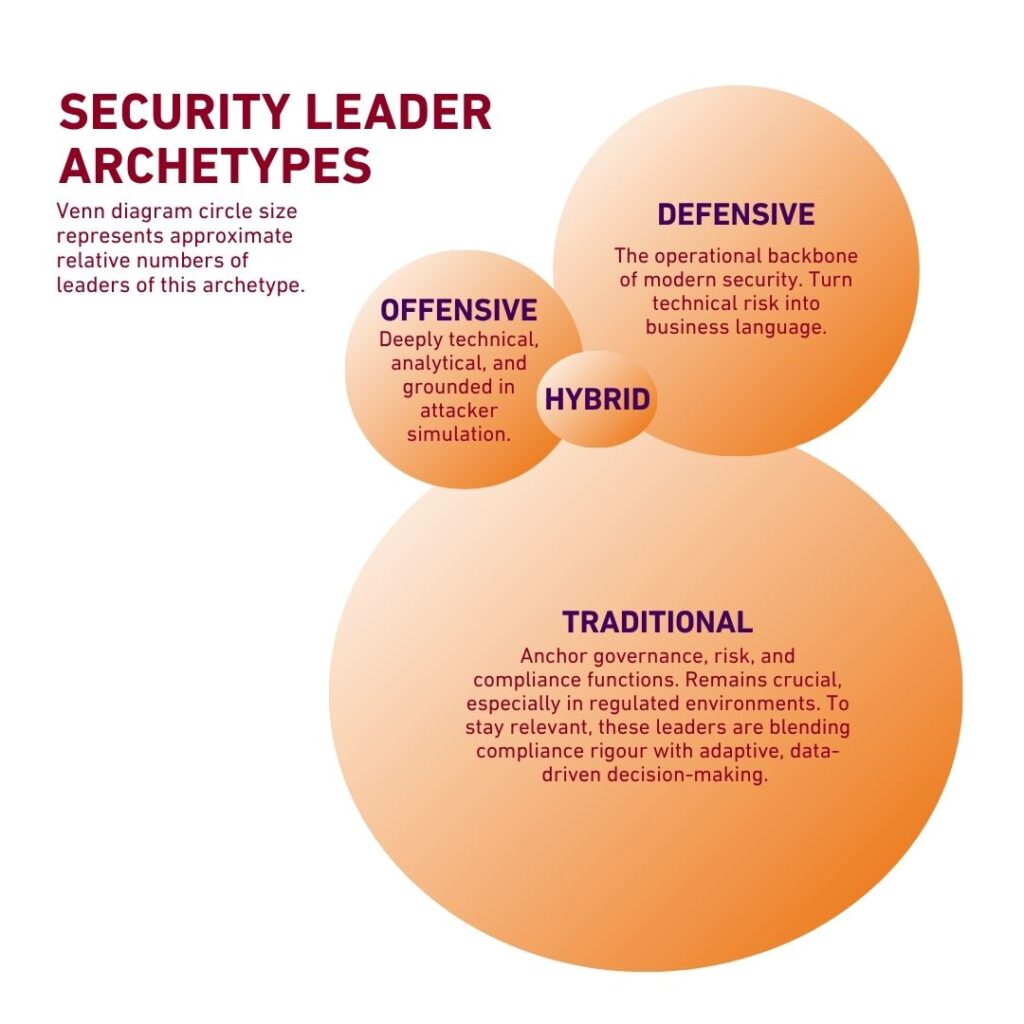How can all boards build resilience?
Optimum security leadership is changing. Firewalls, compliance checklists, and IT governance once defined success. But with nation-state actors escalating their campaigns, AI enabling both attacks and defences, and Europe facing a wave of high-profile breaches, organisations need to evolve their cyber leadership approach.
Savannah’s Talent Intelligence Practice has examined global security talent to uncover numbers and distribution of the archetypes of next generation security leadership. The data shows a stark problem for some sectors in particular: while the demand for senior cyber leaders is soaring, the supply is fragmented, uneven, and under strain.
The Anatomy of Future-Ready Cyber Leadership
Future-ready cybersecurity leadership comprises three overlapping archetypes, Offensive, Defensive, and Traditional, that are rapidly converging into a single hybrid model.
- Defensive leaders represent the operational backbone of modern resilience. Commonly found within telecoms, semiconductors, and financial infrastructure, they combine engineering fluency with cross-functional influence, often straddling technology, operations, and crisis communications. They turn technical risk into business language, translating resilience into something boards can measure, fund, and sustain.
- Offensive leaders have emerged from the red team world: deeply technical, analytical, and grounded in attacker simulation. Concentrated in IT services, consulting, and SaaS ecosystems, they thrive where innovation meets exposure. Their strength lies in anticipation and thinking like attackers to reveal systemic weaknesses before adversaries do. As AI-driven threats accelerate, this proactive element is essential.
- Traditional leaders, by contrast, still anchor governance, risk, and compliance functions, largely within IT services and financial institutions. Their discipline remains crucial, especially in regulated environments, but many are being outpaced by the velocity of modern threats. To stay relevant, these leaders must evolve from oversight to orchestration: blending compliance rigour with adaptive, data-driven decision-making.
When these archetypes overlap, a new profile is emerging, the Hybrid Cyber Leader. This next-generation leader blends the offensive expert’s technical depth, the defensive strategist’s operational breadth, and the traditional custodian’s governance acumen. They move fluidly between the security lab and the boardroom, acting as both translator and tactician.
The future of cyber leadership lies in this convergence. Organisations can no longer rely on single-discipline expertise; they need polymathic leaders who can anticipate attacks, sustain operations, and command strategic trust. In an era where cyber risk equals business risk, the ability to think like an attacker, operate like a defender, and govern like a strategist will define the leaders who stay ahead.

Retail, Gaming and Supply Chain are losing cyber leadership talent
Healthcare and aviation face rising pressure from both cybercriminals and state-backed attackers. These sectors are growing their cyber leader populations at double-digit rates.
Meanwhile, retail, hospitality, and supply chain are losing this talent, shedding critical skills even as they face systemic risks. M&S’s recent cyber incident resulted in £300M expected losses and £700M wiped off its market valuation.
Leadership risk could well be creating an additional cyber risk factor in those companies that are losing talent more quickly than they can replace or even grow it.

What It Means for Leadership & Talent
Leadership needs to evolve with the threat
Compliance-driven IT leaders alone won’t suffice. Organisations need hybrid cyber leaders who bring offensive testing skills, defensive resilience, and board-level strategic authority.
Retention is as important as recruitment
With tenure barely two years and nearly 40% of leaders open to moves, companies that fail to invest in career development, visibility, and retention strategies will continue to lose ground.
Location Strategy is the New Talent Strategy
Talent is no longer evenly distributed. Offensive and defensive leaders are clustering in geopolitical and innovation hotspots, while traditional roles remain concentrated in corporate centres.

Boards must recognise that location and leadership strategy are now inseparable; if your cyber leadership team isn’t near frontline, growing talent pools, you may soon be recruiting from them.
The data shows that cyber leadership growth is uneven, highly competitive, and shaped by geopolitics. The supply-demand gap is widening, and churn is ultra-high.
For boards and CEOs, it’s a leadership and talent pipeline issue. The organisations that thrive will be those that:
- Recognise sectoral differences in growth and risk
- Have robust succession in place, aligned with where cyber risk is most acute
- Plug critical gaps with immediately available relevant skills
Cybersecurity Awareness Month is a reminder: resilience correlates with the quality of leaders we trust to navigate the frontline. Whether it’s quickly resolving gaps with experienced interim leaders, creating pipelines aligned with future risks or recruiting best-in-class cyber leaders, contact us to help you address this issue.




